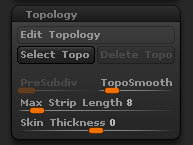
Tool > Toplogy sub-palette
Edit Topology
Once a polymesh has been prepped for retopologization (see the help for Tool > Rigging > Select), pressing the Edit Topology button takes you into retopologization mode. In this mode, the following apply:
- Add a point: Click on desired spot.
- Delete a point: Alt-click on point.
- Set a new starting point: Ctrl-click on point.
- Select a point: LMB-click on the point.
- Deselect a point: LMB-click outside your model.
- Move points: Go from Draw mode to Move mode.
- Move more points at once: Increase the brush size.
- Scale points: Go to Scale mode. (works best with larger draw size)
- Delete a connection-line without deleting the connected points: Insert a new point in the middle of the line and delete that point.
Select Topo
Select Topology Mesh. Prompts you to select a model for which you want to edit topology directly. Allows you to edit an existing model’s topology directly, to do things like add or remove points, connect vertices with new edges, and so on. This is NOT the same as retopologization–for help on that, see the popup note for Tool > Rigging > Select.
Delete Topo
Delete Topology Mesh. Deletes your topology lines.
PreSubdiv
When set to values above 1, Subdiv causes a mesh generated from new topology to be subdived 1 or more times. This is intended for use when the Tool:Rigging:Project switch is on; the subdivision is performed before details are projected onto the new mesh, and as a result, a higher value for Subdiv will allow more details to be captured by the new mesh.
TopoSmooth
Topo Bind Smoothness
Max Strip Length
As you add lines and vertices when retopologizing a model, ZBrush looks for opportunities to automatically add connecting lines where you are likely to want them. Max Strip Length controls how aggressively ZBrush will attempt to autoinsert connecting lines. To turn off this feature entirely, set the value of this control to its minimum. Note that, depending on your workflow, you may find that ZBrush doesn’t autoinsert lines, or inserts them at places you don’t want them. This is a reflection of the fact that each user will do things in a particular way, and ZBrush’s insertion algorithm functions better with some workflows than with others. For tips on retopologizing most efficiently, visit the ZBrush forums, or look through tutorials on this site that use retopoligization.
Skin Thickness
You can create a solid (double-sided) model from single-sided topology using Tool:Adaptive Skin:Make Adaptive Skin. For example, you could create topology for a shoe using a foot as the underlying topology guide. When creating a model in this way, Skin Thickness sets the thickness of the generated double-sided model.